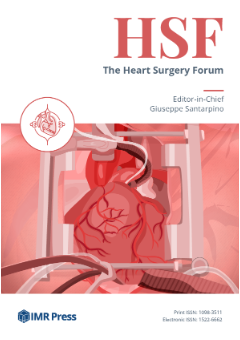Announcements
The Heart Surgery Forum (HSF) is published by IMR Press from Volume 28 Issue 9 (2025). Previous articles were published by another publisher under the CC-BY-NC licence, and they are hosted by IMR Press on imrpress.com as a courtesy and upon agreement.
Open Access
Article
The Use of Bilateral Internal Mammary Arteries for Coronary Revascularization in Patients with COPD: Is It a Good Idea?
Show Less
Affiliation
1
Cardiac Surgery Department, MediClin Heart Institute Lahr/Baden, Lahr, Germany
2
Cardiothoracic Surgery Department, Alexandria University, Alexandria, Egypt
3
School of Medicine, Witten/Herdecke University, Witten, Germany
Heart Surg. Forum 2016, 19(5),
243–247;
https://doi.org/10.1532/hsf.1482
Published:
31 October 2016
Abstract
Background:The use of bilateral internal mammary arteries (BIMA) is limited worldwide, especially in patients with chronic obstructive pulmonary disease (COPD). Thus, we assessed the safety of the use of BIMA in COPD patients.Methods:From cohorts of 8846 patients operated on at our center for primary isolated multi-vessel coronary bypass operations between 2002 and 2012, we studied two propensity-matched groups of patients with COPD who received either single internal mammary artery and saphenous vein grafts (SIMA group: 137 patients) or exclusively BIMA (BIMA group: 137 patients). Preoperative data were similar regarding age (63.59 ± 10.62 versus 65.55 ± 9.61 years;P = .10), body mass index (BMI) (28.6 ± 4.71 versus 28.42 ± 3.86 kg/m2; P = .72), diabetes mellitus (32% versus 27%; P = .08), EuroSCORE (4.34 ± 2.23 versus 4.8 ± 2.52; P = .09) and ejection fraction (58.7 ± 13.08% versus 60.29 ± 14.13%; P = .32).Results:No significant differences were noticed between the two groups regarding the number of peripheral anastomoses (3.07 ± 0.77 versus 3.06 ± 0.85; P = .90), total operation time (192.17 ± 43.06 versus 200.63 ± 39.24 min; P = .08), postoperative stroke (0.7% versus 0%; P = .29), myocardial infarction (2.92% versus 3.6%; P = .81), reintubation (2.9% versus 4.4%; P = .66), reexploration (0.7% versus 2.2%;P = .32), deep sternal wound infection (2.9% versus 3.6%;P = .81) and 30-day mortality (2.2% versus 2.9%; P = .77). However, postoperative blood loss (726.1 ± 468.35 versus 907 ± 890.58 mL; P = .03) was higher in the BIMA group.Conclusion:COPD patients can benefit from coronary artery revascularization with BIMA; however, postoperative blood loss can be higher using this technique.

